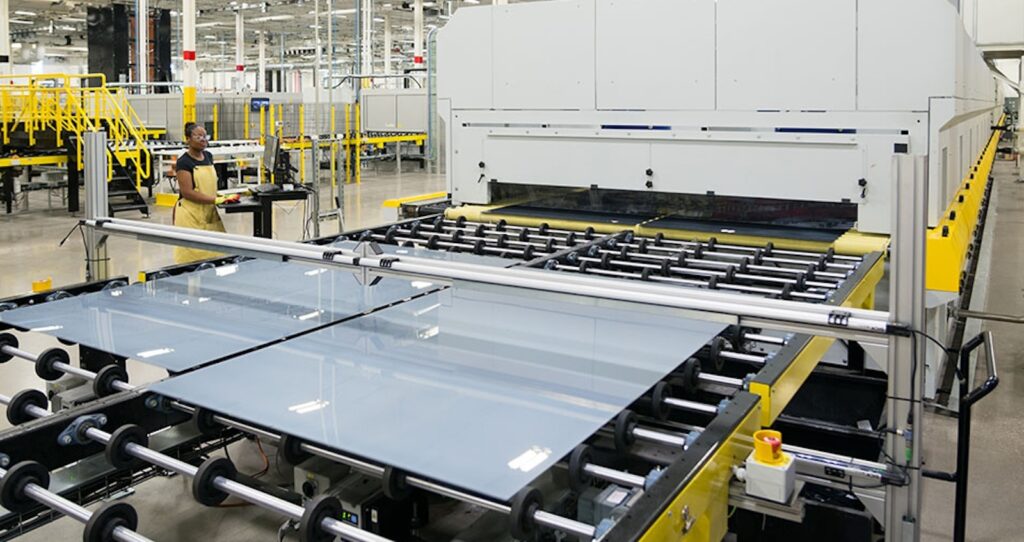
Sign up for daily news updates from CleanTechnica on email. Or follow us on Google News!
Last Updated on: 23rd February 2025, 10:22 am
The conversion to renewable energy-powered production has been remarkable over the last few years.
At least 160 clean energy manufacturing facilities or expansions have been announced since August 2022, driven by tax credits in the Inflation Reduction Act, with 47 declared in 2024 alone. Collectively, these facilities are expected to result in 100,000 new manufacturing jobs and at least $500 billion in investment, $75 billion of which has already been spent.
Domestic manufacturing of solar modules in particular grew substantially in 2024 to surpass 50 GW — enough to meet all existing US solar demand — with five new or expanded manufacturing facilities in Alabama, Florida, Ohio, and Texas. In addition, manufacturing of silicon cells for solar resumed in the US in 2024 for the first time since 2019.
Renewable energy has emerged as a powerful engine of economic activity. However, the industry has faced persistent challenges, including insufficient transmission access, high interest rates, rising local siting opposition, supply chain issues, and misinformation campaigns. These impediments are becoming even stronger under the Trump administration.
The “drill, baby, drill” group has already issued a slew of energy-related executive orders to undo activities from the Biden administration. The Trumpsters love to coddle their fossil fuel funders by promising lots of new development. They want to enhance LNG exports and eviscerate permitting regulations. “Who needs offshore wind leases or electric vehicles?,” they laugh.
Manufacturing and other industrial users account for around a third of the world’s energy consumption, according to the International Energy Agency. Electricity is a central element of that consumption. Yet, if renewable energy-powered production was to become the norm, it would make a sizable contribution to solving climate change. Where can companies start?
- Source renewable electricity from local suppliers via contracts with electricity suppliers. The ability to do this will depend on the rules in a particular country, but, if it is possible, a company can be confident its electricity is only coming from renewable sources.
- Generate electricity on-site, via rooftop solar panels, or, if space allows, from wind turbines. Even if companies do not generate all the power needed, even partial renewable energy-powered independence makes a real contribution.
- Develop battery storage facilities. Some business owners fear that renewable electricity supply will be interrupted when the wind isn’t blowing or the sun isn’t shining. Battery storage technology heads off that concern.
Renewable-Energy Powered Production at the Granular Level
Think that renewable energy-powered business can’t be done? Well, it can. The 2025 Global 100 lists the world’s most sustainable companies — and how they are still betting on a greener world even with the backdrop of autocrats propped up by Big Oil. It’s happening in the US, too, albeit not with the robust energy that’s happening in other countries. Here are some examples:
Enphase Energy, Fremont, CA released its 2023 ESG report last May. Key highlights include:
- Microinverters have produced 80.6 terawatt hours (TWh) of clean energy since inception of the company.
- The company’s installer count has grown to more than 8,700, further enabling rapid deployment of its renewable energy management systems worldwide.
- Continued collaboration with GRID Alternatives has helped to bring solar installations to more than 10,000 low and moderate income households over the course of the relationship.
Enphase has earned an ESG “Prime” rating from Institutional Shareholder Services, a “AA” ESG rating from Morgan Stanley Capital International, and a reduced risk rating from Sustainalytics, reflecting our ongoing commitment to sustainability.
First Solar, Inc., Tempe, AZ relates that its products are projected to displace 84 million metric tons of CO2eq per year during their 30+ year product life [by 2030]. Tare projected to displace 84 million metric tons of CO2eq per year during their 30+ year product life [by 2030]. Every year, 60 GW of First Solar products displace 38 million metric tons of CO2eq, which is more than seven times the amount of greenhouse gas emissions (GHG) they emit through their global operations and supply chain.
Assuming worldwide average irradiance and grid electricity emissions, the company estimates that the 12.1 GWdc of products produced in 2023 alone are being used to displace 7.6 million metric tons CO2e per year, or 228 million metric tons of CO2eq over their 30+ year product life.
Steel Dynamics, Fort Wayne, IN incorporates a variety of sustainability practices within its commitment to operate in an environmentally responsible manner. With electric arc furnace steelmaking, a North American recycling business, a circular manufacturing model, and innovative teams, Steel Dynamics is already a leader in the production of lower-carbon steel products within the global industry. They continue to encourage the research and use of new technologies and processes to further reduce their impact on the environment, including a strategic focus on lowering carbon emissions with a goal for their steel mills to be carbon neutral by 2050.
From Oats to Plant-Based Milk: A Power-Filled Case Study
Cow’s milk has significantly higher impacts than plant-based alternatives across all metrics. It causes around three times as much greenhouse gas emissions; uses around ten times as much land; uses two to twenty times as much freshwater; and creates much higher levels of eutrophication. If you want to reduce the environmental footprint of your diet, switching to plant-based alternatives is a good option.
Plant-based milk alternatives produce one-third of the GHG emissions when compared with cattle milk. Yet plant-based milk needs fossil fuels to power the process to turn plants into milk.
Let’s consider that Oatly’s factory in Millville, New Jersey, is the production facility for the company’s thick liquid base that will later become oat milk. Oat grains that arrived by train and truck from western Canada are conveyed inside, cracked open, stirred with water, mixed with enzymes, then spun in loudly whirring decanters. The decanters separate smooth liquid from gloopy, fibrous residue, as described by Maria Gallucci on Canary Media.
The steam heat that is necessary for these processes is generated in the boiler room, where giant cylindrical tanks burn large volumes of cheap and abundant natural gas every day. Steam heat has been the norm in the industry for a very long time.
The company’s Original Oatmilk has about half the climate impact of US dairy milk on a lifecycle basis, without any methane-burping and manure-making cows, and from sourcing renewable-energy credits for 100% of the electricity used at its six global facilities.
Oatly wants to become a fully sustainable company, but there are many challenges to achieving this goal. It recycles the plant’s waste heat. It would like to install industrial heat pumps and other electrified technology to replace its gas-fired boilers and reduce carbon emissions, but the gas system is relatively new and hold lots more years of use.
Consumers and investors are increasingly likely to reward companies with greener credentials, making it an essential part of long term market positioning. In addition, the folks at Oatly realize that greater use of renewables and greater self-generation can make a company more resilient to volatile electricity prices on the open market.
Chip in a few dollars a month to help support independent cleantech coverage that helps to accelerate the cleantech revolution!
Have a tip for CleanTechnica? Want to advertise? Want to suggest a guest for our CleanTech Talk podcast? Contact us here.
Sign up for our daily newsletter for 15 new cleantech stories a day. Or sign up for our weekly one if daily is too frequent.
CleanTechnica uses affiliate links. See our policy here.
CleanTechnica’s Comment Policy

